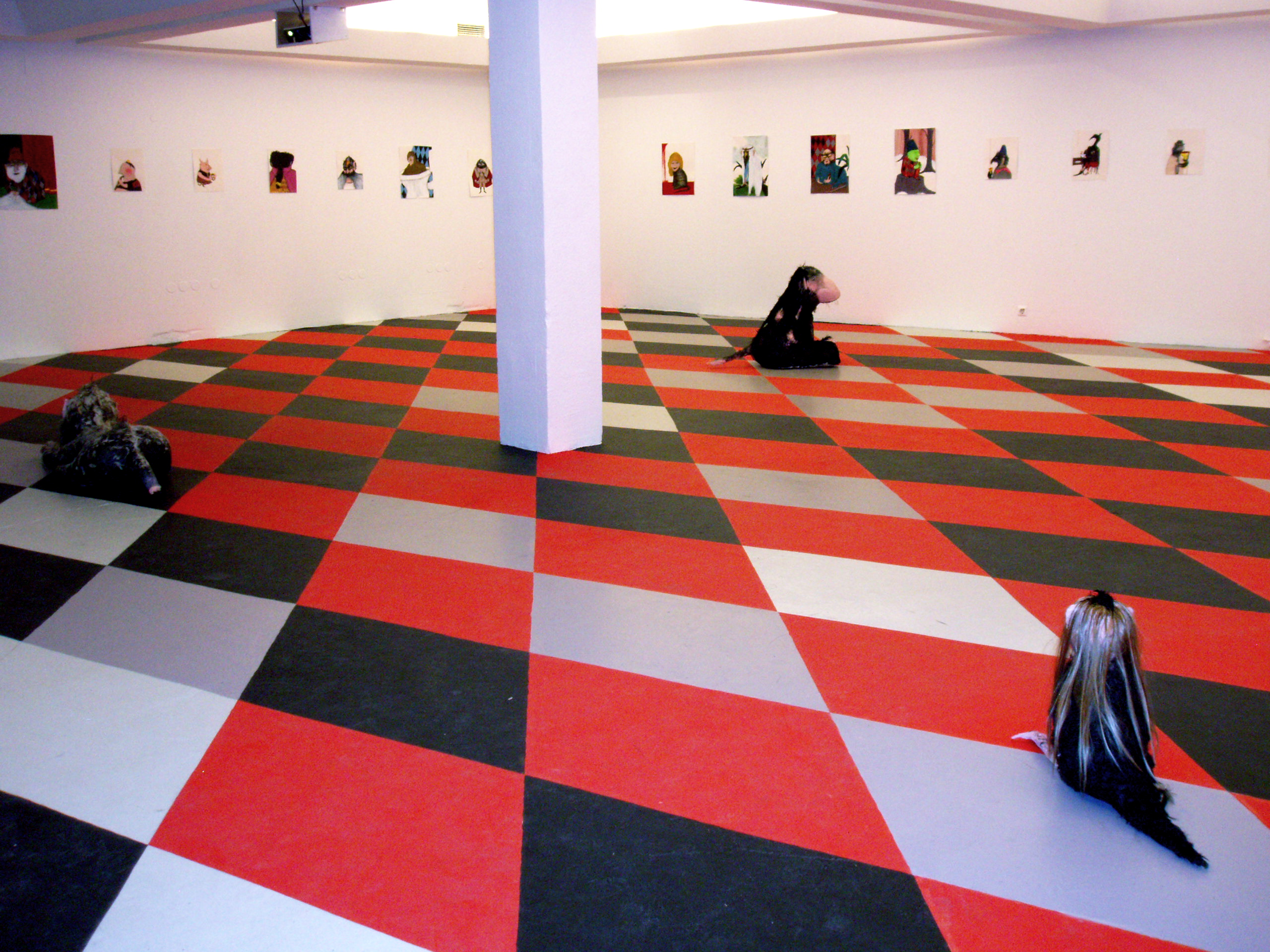Sigga Björg Sigurðardóttir, All images courtesy of artist and Kling and Bang, Reykjavik
In "33" at Kling and Bang gallery in Reykjavik, Iceland, Sigga Björg Sigurðardóttir acts as sub-creator, naming the unseen and unnameable and thus bestowing life upon fantastic hybrid entities. The space is full of wildness: A red, black and grey game-board floor suggests a sequence of movements that is menacingly playful, with potentially high stakes, and the duplicate dimensions of work, with mirror-like repetitions, hints at illusion and potential trickery. Sigga's sculptures and works on paper evoke H.P. Lovecraft's "fantastic dream of unknown and half-known shapes", summoning "forest-born and ice-fostered whisperings... shapeless spawn... eldritch weirdness." Her work engages with the expression of human ways, three-dimensional forces, and unearthly things, and her chorus of yellow and crimson-eyed creatures may drink from a poisoned chalice, or deal us clubs, diamonds, hearts and spades. The fragmentation of forces, dispersed by enchantment, leads to alluring strangeness and uncharted dimensions.
Can you describe the thought processes and inspiration surrounding your solo show, "33," at Kling and Bang? In particular, can you tell me about the three sculptures?
The idea is pretty basic. I am showing 33 characters. Thirty drawings and three sculptures. What is maybe different in this show is that the characters now have a face and a name. Before, my characters were more like faceless creatures that were expressing some kind of situation or a feeling mainly through body language, outfits, etc. This is the first time I decided to look them in the eyes and give them names. This is also the first time I made sculptures. I actually don't really know why I started making the sculptures but at some point in the process of making this exhibition, I had a terrible nightmare. I dreamt that I had a pet cat that I loved very much and something horrible happened that made my cat turn two dimensional... okay, it was a long and weird dream but something about this dream actually made me start experimenting with making three-dimensional creature.
What inspires you to often portray hybrids and chimeras, and what role does naming play in this body of work?
I have a big interest in all different creatures. Both animals and humans. I like to watch how they behave and don't behave. Naming plays a big role in this new series of 33 characters. By giving them a face and a name I feel like I am taking a step towards getting to know them and approaching them in a different way. Not only as a viewer from a distance. I feel like this is more personal.
Is this body of work influenced by the Icelandic folklore of hidden people, elves, or nature-beings (and do you believe)? How would you describe the ways in which the awe-striking environment affects one's consciousness, in Iceland?
I wouldn't say that this body of work or any of my work is directly influenced by Icelandic folklore. Icelandic nature is pretty dramatic and powerful and it is impossible to live here and not be influenced by the surroundings. Of course there are lots of elves/hidden people etc., here and there is no reason to doubt their existence. Being from here it is hard to know how the environment is affecting us here. It makes sense to be influenced by the place I am from but I am in no way directly working with Icelandic folktales. My characters are influenced by people I have met all over the world. Half of this series I made in Austria. I stayed there for a three-month residency recently in a town called Krems. In some of the works I can see afterwards that there are Austrian elements in the characters. It was surprisingly exotic for a person from Iceland to stay in a such Catholic surroundings. But it was an inspiring three months.
What is the artistic community like in Iceland; as an outside observer, it appears very close-knit, conversational, and collaborative -- does this ring true? Do you think that there is a common undercurrent among Icelandic artists?
In my opinion the Icelandic artist community is pretty big, considering how small the population is here. In the center of Reykjavík every other person seems to be some kind of artist, musician, writer, etc. However, it is a small town so we all more or less know each other and it is very collaborative and creative. I don't know if there is a common undertone? It doesn't feel like that but maybe someone from abroad would see that better than I do. I find artists here to be very individually strong and the scene pretty diverse actually.
What is your studio practice like in Reykjavik? What are you now working on?
I work in my studio in Reykjavík every day. Since the opening of the show "33," I have finished an album cover for musician Mikael Lind and now I have just started working on a new animation and sculptures.

